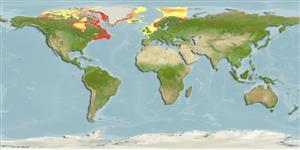Environment: milieu / climate zone / depth range / distribution range
Ecologia
marino demersale; distribuzione batimetrica 30 - 400 m (Ref. 58496), usually 60 - 200 m (Ref. 4701). Polar; -2°C - 3°C (Ref. 4701); 83°N - 42°N, 136°W - 69°E
Arctic, Northwest to Northeast Atlantic: Barents Sea to Franz Josef Land, Spitzbergen, Greenland, and south along North American coast to Massachusetts (Ref. 48811); including Iceland and Norway (Ref. 4701); Canadian Arctic to Hudson Bay in Canada (Ref. 7251).
Size / Peso / Age
Maturity: Lm ? range ? - ? cm
Max length : 13.2 cm NG maschio/sesso non determinato; (Ref. 58426)
Inhabits stony bottoms (Ref. 4701). Benthic species. Feeds on crustaceans, oikopleura and fishes (Ref. 58426).
Life cycle and mating behavior
Maturities | Riproduzione | Spawnings | Egg(s) | Fecundities | Larve
Stein, D.L., 1986. Cyclopteridae. p. 1269-1274. In P.J.P. Whitehead, M.-L. Bauchot, J.-C. Hureau, J. Nielsen and E. Tortonese (eds.) Fishes of the North-eastern Atlantic and the Mediterranean. UNESCO, Paris. Vol. III. (Ref. 4701)
IUCN Red List Status (Ref. 130435)
Threat to humans
Harmless
Human uses
Strumenti
Special reports
Download XML
Fonti Internet
Estimates based on models
Preferred temperature (Ref.
123201): -1 - 7.1, mean 0.8 °C (based on 559 cells).
Phylogenetic diversity index (Ref.
82804): PD
50 = 0.5000 [Uniqueness, from 0.5 = low to 2.0 = high].
Bayesian length-weight: a=0.02089 (0.00774 - 0.05639), b=3.03 (2.79 - 3.27), in cm total length, based on LWR estimates for this (Sub)family-body shape (Ref.
93245).
Trophic level (Ref.
69278): 3.2 ±0.40 se; based on food items.
Resilienza (Ref.
120179): Medio, tempo minimo di raddoppiamento della popolazione 1.4 - 4.4 anni (Assuming tmax=3-10).
Fishing Vulnerability (Ref.
59153): Low vulnerability (10 of 100).
